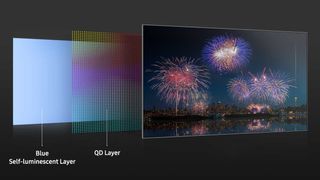Samsung is experiencing production issues with its new QD-OLED displays, reports The Elec (via hdtvtest).
The Korean news outlet reckons the main obstacle is the "low production yield rate of the panels... around 30% currently". That doesn't sound like a great strike rate to be fair.
Samsung Display is said to be considering investing in production with a view to boosting yield rates, but is rumoured to be "holding off" until such times as it can properly gauge "customer reaction to QD-OLED".
The Elec's Sources say that even if Samsung Display does throw a big bundle of cash at the problem, QD-OLED capacity could "remain limited at 30,000 Gen 8.5 substrates monthly until the end of 2023" (it can take many months to expand production, apparently).
Not familiar with QD-OLED? The new tech aims to combine the dark, saturated blacks of OLED with the vivid contrast of Quantum Dots. Here's our QD-OLED explainer, if you want chapter and verse.
Samsung officially officially started mass production of QD-OLED panels in late 2021, almost two years after the company announced an $11 billion investment in the tech.
The first QD-OLED TV debuted at January's Consumer Electronics Show. The Sony Master Series A95K QD-OLED, which is due out in the first half of 2022, uses a Samsung Display panel. Samsung's own QD-OLED TV has been leaked but not officially announced.
If customers do take to QD-OLED, sources expect Samsung to target a yield rate of 70%, which could allow the firm to churn out one million QD-OLED panels a year (split between TVs and gaming monitors).
Wondering how Samsung's next-gen panel compares to LG's OLED Evo display? Here's a preview of two upcoming flagship TVs: Sony A94K QD-OLED vs LG G2 OLED Evo TV.
MORE:
LG 2022 TV lineup: everything you need to know
QD-OLED TV: everything you need to know about the game-changing new TV tech
